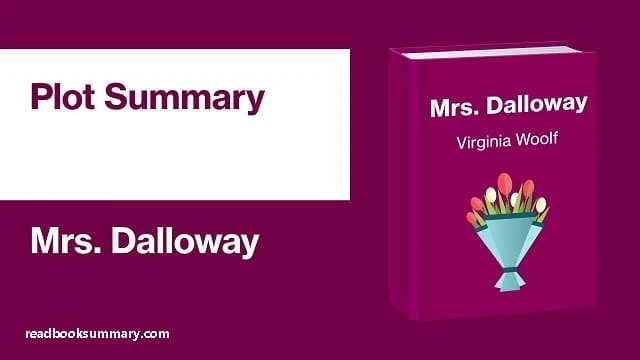Mrs. Dalloway Summary, it is a novel by Virginia Woolf published on 14 May 1925. It details a day in the life of Clarissa Dalloway, a fictional upper-class woman in post-First World War England. It is one of Woolf's best-known novels.
The working title of Mrs. Dalloway was The Hours. The novel began with two short stories, "Mrs. Dalloway in Bond Street" and the unfinished "The Prime Minister". The book describes Clarissa's preparations for a party she will host in the evening and the ensuing party. With an interior perspective, the story travels forwards and backwards in time, to construct an image of Clarissa's life and the inter-war social structure. The novel addresses the nature of time in personal experience through multiple interwoven stories.
 |
| Mrs. Dalloway Book Summary |
Mrs Dalloway Summary
Mrs. dallawi's novel tells about events that take place on Wednesday, mid-June of 1923, and also talks about two unrelated stories during this day, as the first story starts talking about 50-year-old dallawi, who is preparing to attend one of the parties, and it is worth mentioning that dallawi recently recovered from illness.
Before going to the party, Dalloway begins to remember one of her old friends, and the events of the second story begin to tell about Septimus, who was injured by a shell fragment during the first World War, he was suffering from the effects of the war, and he feels that life has no meaning, and he continues to talk inside his mind with his friend who lost him during the war.
Dalloway meets her old friend Peter before he goes out to the party to start the two of them exchanging conversations about the present time, but in their minds they think about the decisions they made in the past, which brought them to the future in this way, and then Septimus begins to tell his wife that he is thinking about suicide so that his wife offers him to undergo psychotherapy.
There is an interview with Septimus, but he does not want to meet the attendees, so he decides to escape from them through the window until he falls to the ground and dies, as Dalloway's party begins and most of the invitees arrive, but she continues to talk with her friends in the past inside her mind, and then the news of the death of one of the patients undergoing treatment at Sir William, Septimus, ends the party with disappointment.
 |
| mrs dalloway summary |
 |
| virginia woolf mrs dalloway summary |
 |
| mrs dalloway plot |
Mrs Dalloway Character List
Clarissa Dalloway: she is the main character of the novel, and is interested in other people's opinions about her.
Septimus Warren Smith: a veteran of the first World War, he is also married to an Italian woman named Lucrezia.
Peter Walsh: he is a friend of Dalloway, and Peter is also known to be very critical of others, and opposes a lot of things.
Sally Seaton: she is a beautiful girl, suffers from the scourge of smoking, says everything that comes to mind, she was also close friends with Dalloway and Peter in their youth.
Richard Dalloway: he is Dalloway's husband and a member of Parliament, and he is also known as a sports person who loves his country.



Questions about Mrs Dalloway Plot
What is the main point of Mrs. Dalloway?
Mrs Dalloway, which takes place on one day in June 1923, shows how the First World War continued to affect those who had lived through it, five years after it ended. David Bradshaw explores the novel's commemoration of the dead and evocations of trauma and mourning.
What is Mrs. Dalloway about short summary?
Mrs. Dalloway, through its depiction of Clarissa and Septimus, who can be seen as foils for each other, and of the political atmosphere in Britain during the 1920s, explores the fragmented yet fluid nature of time and the interconnectedness of perception and reality across individuals and social spheres.
What is so great about Mrs. Dalloway?
Mrs Dalloway is a momentous novel, but the fictional day across which it takes place is not; it is just another day. And it is this fact – that a day, no matter how banal, might contain and symbolise the accumulation of them all – that gives them meaning, as it always has.
What is the symbolism of Mrs. Dalloway?
The old woman in the window across from Clarissa's house represents the privacy of the soul and the loneliness that goes with it, both of which will increase as Clarissa grows older. Clarissa sees the future in the old woman: She herself will grow old and become more and more alone, since that is the nature of life
What is the moral of Mrs. Dalloway?
To do better, to understand and to be understood, we have to start practicing sharing your thoughts, and even before you can do that, you have to start paying attention to your thoughts, and then you have to make a point of asking people about their own.
What is the theme of Clarissa?
Clarissa's great struggle is for a sense of autonomy in a society that prohibits women from wielding any power whatsoever. The Harlowes intend to use their daughter to heighten their rank in the bourgeois community; by contrast, all Clarissa desires is the right to personal happiness and her parent's consent.
What emotion is Mrs Dalloway?
Mrs Dalloway is filled with repression. Our title character, Clarissa, is constantly holding in emotion so she can conform to English social standards. What she feels on the inside and what she projects to the outside world are very different. Inside, she has deep feelings of anxiety and a big fear of death.
Is Mrs Dalloway a feminist novel?
As we see, two stories are being discussed in the novel at the same time and the interesting aspect is that there is no relation between these two stories... Mrs. Dalloway, written by Virginia Woolf, is a piece of modernist literature that many regard as one of the most groundbreaking feminist works ever composed.
What is the most important conflict in Mrs Dalloway?
Set in June 1923, the First World War (1914–18) still hangs heavy in Mrs Dalloway's hot London air, reinforcing how for Virginia Woolf and her fellow Britons the trauma of the conflict was ongoing, its unprecedented devastation still raw and ineradicable for the relatives, friends and loved ones of the unreturned.
What kind of character is Mrs Dalloway?
Clarissa Dalloway, the heroine of the novel, struggles constantly to balance her internal life with the external world. Her world consists of glittering surfaces, such as fine fashion, parties, and high society, but as she moves through that world she probes beneath those surfaces in search of deeper meaning.
Does Mrs Dalloway have a happy ending?
After these great revelations, Clarissa returns to the party. Quite simply, she delights Peter with her return. He no longer denies the deepness of his feeling for her, and her presence changes the moment. A surprisingly optimistic ending indeed.
What happens at the end of Mrs Dalloway?
The novel ends as Clarissa is approaching Peter. We end by observing Clarissa Dalloway, along with Peter, as he says, "there she was." We see multiple images; we see the mystery, the variety and the richness of a human being who is far more than a hostess.
What kind of character is Clarissa Dalloway?
Clarissa is vivacious and cares a great deal about what people think of her, but she is also self-reflective. She often questions life's true meaning, wondering whether happiness is truly possible.
What is the theme of modernism in Mrs Dalloway?
Mrs. Dalloway (1925) by Virginia Woolf is an acknowledged modernist novel which includes the sense of change and disillusionment as modernist elements. Woolf provides readers with illustrations of characters highlighting illusional reality and disillusionment throughout the novel.
What is the irony in Mrs. Dalloway?
Dalloway and the Dalloway house differ. Clarissa, inside, is a mass of doubts and fears. This is dramatic irony because Lucy, Clarissa's maid, worships her mistress and imagines Clarissa to be as regal and composed as she appears to be. We see the truth of the matter when we enter Clarissa's mind.
What is the religious imagery in Mrs. Dalloway?
Woolf's stream-of-consciousness technique reveals the soul as a “sacred” space or “sanctuary,” and her allusions to Christ in the character of Septimus Smith, and less obviously Clarissa Dalloway, suggest yearning for answers to human suffering in a “godless” world.
Is Mrs. Dalloway a satire?
Mrs Dalloway satirizes the superficial nature of the British upper class in the 1920s. The novel particularly focuses on privileged and rather vapid characters like Lady Bruton, who is extremely self-important and cares about the way she's perceived more than anything else.
What is the feminist theme in Mrs. Dalloway?
Feminine creativity and feminine modes of perception are the basic themes of the novel Mrs. Dalloway, and Clarissa has "that extraordinary gift, that woman's gift of making a world of her own wherever she happened to be".
Who are the two main characters in Mrs. Dalloway?
Clarissa Dalloway A delicate lady of fifty; the wife of Richard Dalloway. Richard Dalloway Quiet, gentle; holds a government post.
What does death mean in Mrs. Dalloway?
Death was an attempt to communicate; people feeling the impossibility of reaching the centre which, mystically, evaded them; closeness drew apart; rapture faded, one was alone. There was an embrace in death.
What is the significance of death in Mrs. Dalloway?
Death was defiance. Death was an attempt to communicate; people feeling the impossibility of reaching the centre, which, mystically, evaded them; closeness drew apart; rapture faded, one was alone. Clarissa realises that she 'felt somehow very like him — the young man who had killed himself.
